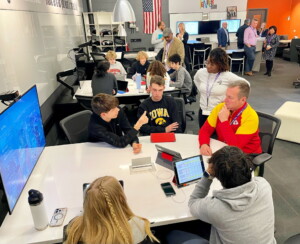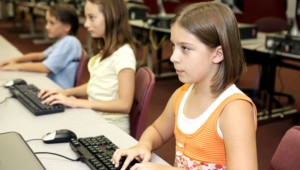The Keys to High Quality PBL: Public Products and Presentations of Work

Public products and presentations of student learning are key to truly high quality PBL. One way to engage students in publicly presenting their projects, products and learning is through exhibition nights.
Exhibition nights provide both students and participants (students are often both at their own Exhibition Nights) a chance to engage, connect and reflect:
- Engage: Learn about the project, see the product (in action if possible) and provide feedback or ask/answer questions.
- Connect/Collaborate: Draw parallels between the project and another student’s work, understand how an outside expert or community member can further the project, and reconnect with peers.
- Reflect: Students and visitors ought to reflect on the project and the power of a community coming together to focus on deeper learning and start to wonder about what’s next.
Take it from Michelle Clark of the ShareYourLearning campaign (focused on student exhibitions, student-led conferences and sharing student work) shared in a post on the Teaching Channel blog: “Public presentations of learning offer a feasible, high-leverage approach to access equitable outcomes for all students through the cultivation of deeper learning competencies.”
It is important to note (and look for a blog on this topic coming your way soon) that, before we discuss public presentations of learning in the form of an exhibition, there are a plethora of ways in which students can present their learning, and an endless number of products they could potentially create. Student publications (which also could be shared during an exhibition night) such as blogs, books, magazines and videos (to name a few) are excellent ways to share student work, and also are great products to share with clients, their peers and the community. Creating publications and sharing them publically (be it digitally or not) is a great way for students to collect feedback and understand how they might improve their work. Now, back to exhibitions…
We recently visited School21 on their tri-annual exhibition night and saw just how well they are engaging, connecting/collaborating and reflecting. Head due east from central London and you’ll find yourself in the township of Stratford. While still very much a part of the city proper, the community has a small neighborhood feel and lively energy.

Tucked away on one of the side streets is School21 – an innovative 4-18 public school focused on “the need for schools to rebalance head (academic success), heart (character and well-being) and hand (generating ideas, problem-solving, making a difference).” You enter the building through gates and it is as if you are suddenly in a different world. Students are joyfully skipping about in and out of the building, weaving from classroom to classroom.
Engage
I started my tour of their exhibition night outside watching students lead other students through a go-kart track. My initial thought was that it looked like a fun project-based experience, but I came to realize that yes, it was fun – but that there was so much more to it. This was quite an in-depth, integrated and challenging project.


As I approached, I saw some students fixing the go-karts, others trying them out, and a handful there to discuss and share the project. What I learned from the students was that they not only had to design and build the go-karts and make the mathematical calculations so that they functioned and were safe, but that they integrated art, physics and real world applications into their work. Students just that week had raced the karts at a community track to test speed and functionality. They were all engaged, and very eager to participate.
Connect/Collaborate
I pulled myself away from the presentations outside and entered the jam-packed auditorium, complete with a musical performance, a miniature golf course and a coding and gaming station. Mind you — everything I was seeing was student-created and student-led. There were certainly lead teachers to be found, but there was not massive oversight or management of students. I sat down next to a 4th-year student who shared more about the project he worked on over the course of nine weeks. He shared details about the game he created, right down to the variables needed to code it on the backend. I started to get up, but he insisted I stay, and peppered me with questions about his work and what I thought. He was actively seeking feedback and an authentic connection that would help him improve his project. This exchange was not a rarity — many students I talked to not only mentioned experts that they had collaborated with, but were insistent on gathering even more advice and ideas.

Students were connecting not only with me and the other visitors and parents, but also with each other. You could tell that some of them very much view these projects as on-going work and efforts that are never quite done. Huddling in the corner were two students comparing presentations and collaborating on improvements to their games.


Reflect
As I walked around, students knew what to do and where to be. I overheard several students reminding each other that they had about ten minutes before their presentation time. The students who were presenting were also aware of the task at hand – engaging whoever came to see their presentation by seeking genuinely curious about their questions and feedback.

I walked into one room where t-shirts were hanging from the ceiling with messages about civil rights issues and promoting hope. On the projector was a video of students interviewing local community members about their thoughts on particular issues and students sharing reflections of their own.
Two students I listened to were presenting on their Real World Project (provides authentic placements in workplaces where students to solve real problems), which have deliberate connections to a local organization or group, and they stayed through their time and continued to address questions. They literally had a slide up that simply said reflections, where they shared their own reflections and encouraged feedback.

What I came to realize from this visit was that within the excitement and energy was an incredibly well planned, managed and thought out project exhibition night. These students worked hard and produced work as a result of their projects that was meaningful and not contrived. The effect of these public presentations of learning was surely going to last longer than the two hours that evening. While these presentations were just snippets of the grander projects they had worked on, it was clear there students were engaging in HQ PBL. Without this public presentation of the products they had worked on students would’ve missed out on an opportunity to engage, connect and reflect.
Anna Kyrk, lead of the PBL work at School21, works hard to orchestrate exhibition nights with the rest of the incredible staff. There was structure and standards built into the projects but it was clear teachers and students had autonomy and choice. If you get the chance, be sure to virtually check out some of the School21 projects and stay tuned for a full case study about their PBL practices coming in March 2018.

This blog is a part of the High Quality Project Based Learning Campaign supported by the Buck Institute for Education and sponsored by the Project Management Institute Educational Foundation and the Hewlett Foundation. For more, visit hqpbl.org and follow @hqpbl #hqpbl on Twitter and Instagram.
Many thanks to the team at School21. Images used in this post were provided by School21.
For more, see:
- High Quality PBL Framework on the Horizon
- What We Are Doing to Ensure High Quality PBL For All
- 35 Leaders on the Successes and Challenges of Project-Based Learning
- 30 Leaders on the Successes and Challenges of Project-Based Learning
- Two EdLeaders on Global, High Quality Project-Based Learning
Stay in-the-know with all things EdTech and innovations in learning by signing up to receive the weekly Smart Update.







0 Comments
Leave a Comment
Your email address will not be published. All fields are required.